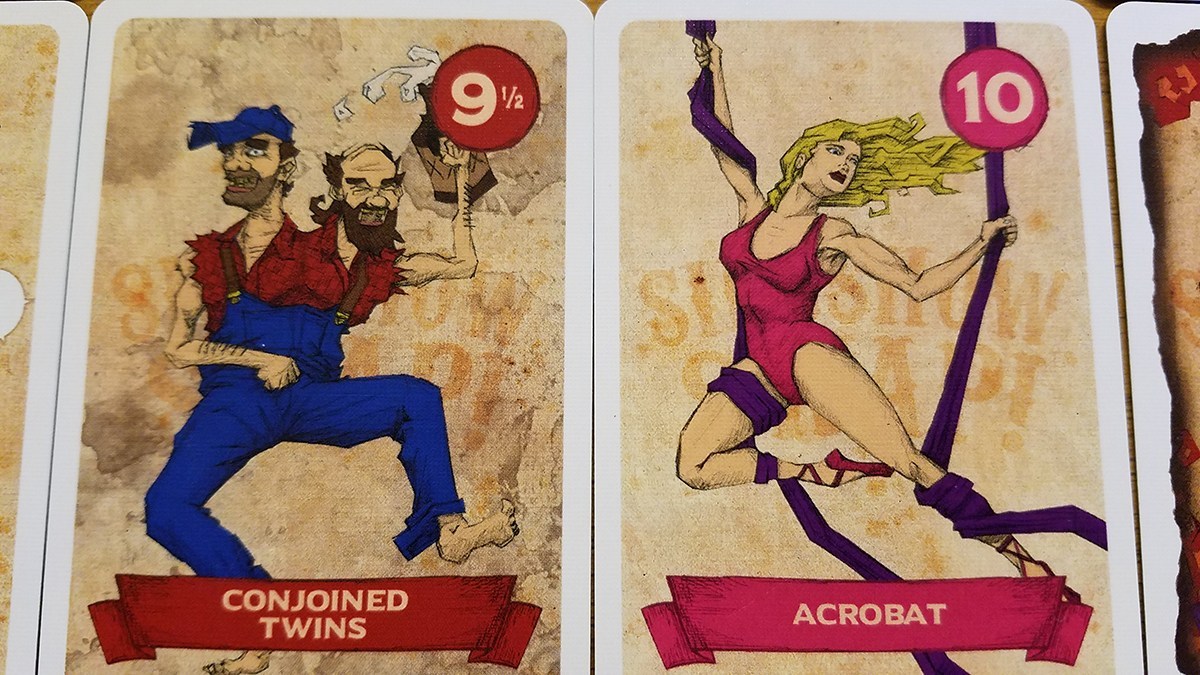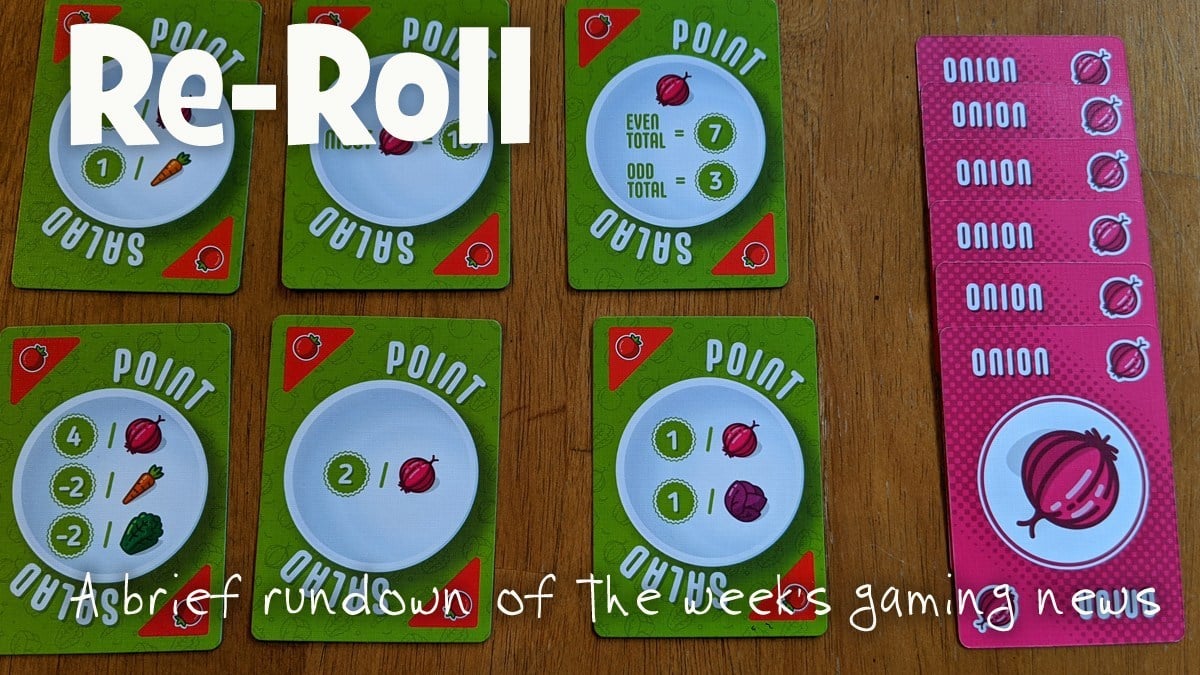There are monsters to slay and magical chalices to retrieve: quests that require legendary heroes. Not everyone is cut out to be a hero. However, you can help craft the armor, weapons, and accessories those heroes will need to be successful.
At a glance: Guild Masters is for 2 to 5 players, ages 14 and up, and takes 60–90 minutes to play. It’s designed by Matthew Austin and published by Mirror Box Games, and is currently seeking funding on Kickstarter, with a pledge of $50 for a copy of the game (or $10 for the print and play files). Although the game does have some complexity in the strategy, the gameplay itself is not too difficult, and I think that younger players with some experience in resource-management games may be able to enjoy it as well—there isn’t any inappropriate content. The game is a mix of resource management and set collection.
New to Kickstarter? Check out our crowdfunding primer, and visit our curated page for more projects we love.
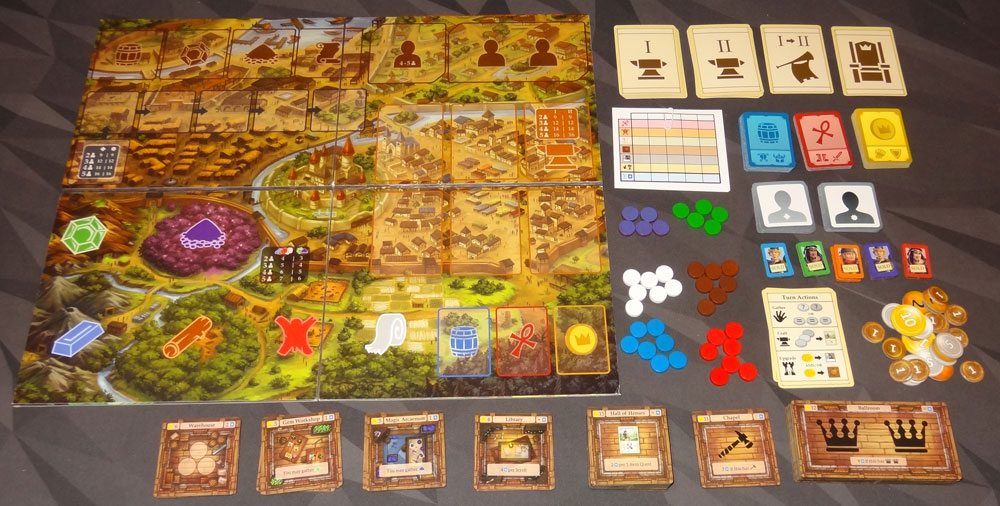
Components
Note: My review is based on a prototype, and much of the artwork and graphic design is not final. The finished game will have new icons and card designs, artwork for the individual items and treasures, different heroes on the quest cards, and so on. It is also possible that components may change due to stretch goals reached during the Kickstarter campaign.
The game includes:
- 1 game board
- 42 resource tokens (7 each in Cloth, Leather, Metal, Wood; 6 each in Gems and Magic)
- 5 Guild tiles
- 16 Item Sold markers (3 per guild)
- 36 Quest cards (in two ages)
- 1 King’s Herald card
- 1 King card
- 78 Treasure cards (26 each in blue, red, and yellow)
- 36 Worker cards (18 each in two types)
- 35 Room tiles:
- 12 common rooms (3 each Warehouses, Magic Arcaneums, Gem Workshops, Libraries)
- 9 Chambers (6 large, 3 small)
- 14 Halls
- 65 Coins (35 copper, 15 silver, 15 gold)
- 5 Player reference cards
The preliminary artwork looks pretty nice, with spaces on the board for resources, cards, and tiles, plus some setup reminder charts. I can’t comment too much on the look since I know a lot of the artwork will change, but the preliminary artwork for the heroes and workers is nice, and I also like the room illustrations—they line up with your Guild tile to create a top-down view of an expanding building.
How to Play
You can download a copy of the rules here.
The object of the game is to have the most points by the time the King arrives at the end of the second age—you earn points by helping heroes complete quests, collecting certain types of treasures, hiring workers, and by adding to your guildhall.
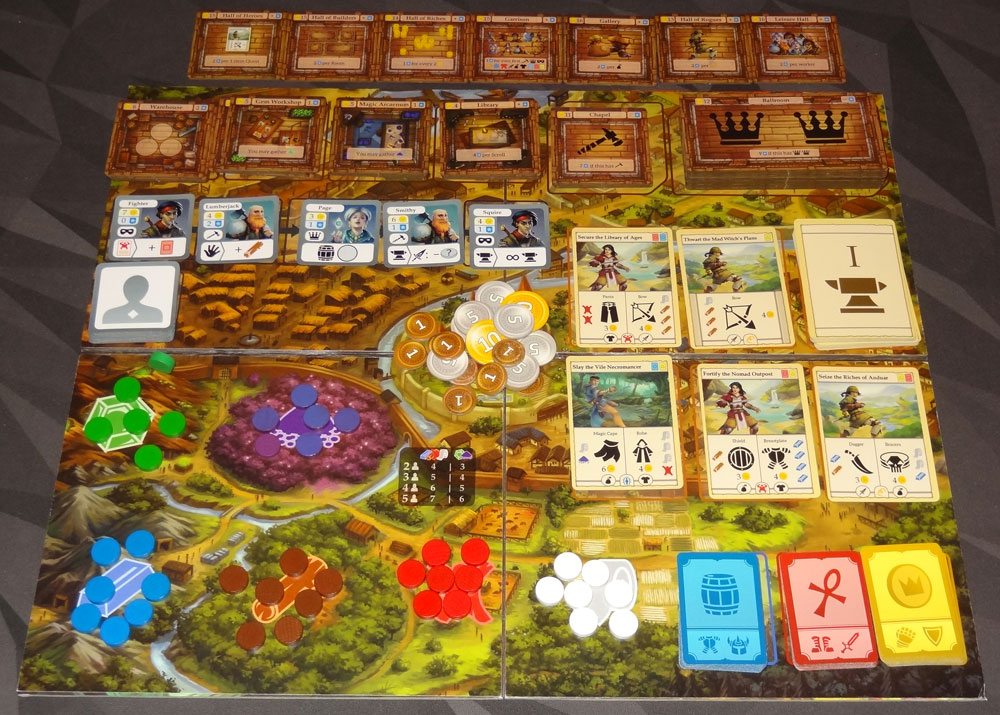
To set up, various things will be placed on designated areas of the board: rooms, chambers, workers, quests, resources, money, and treasure cards. Depending on the number of players, you will remove a certain number of cards, tiles, and resources. The deck of worker is separated into two types, with the basic types on the top half of the deck. The quest cards are divided into two ages, with the king’s herald sandwiched between the two ages, and the king card at the very bottom of the deck.
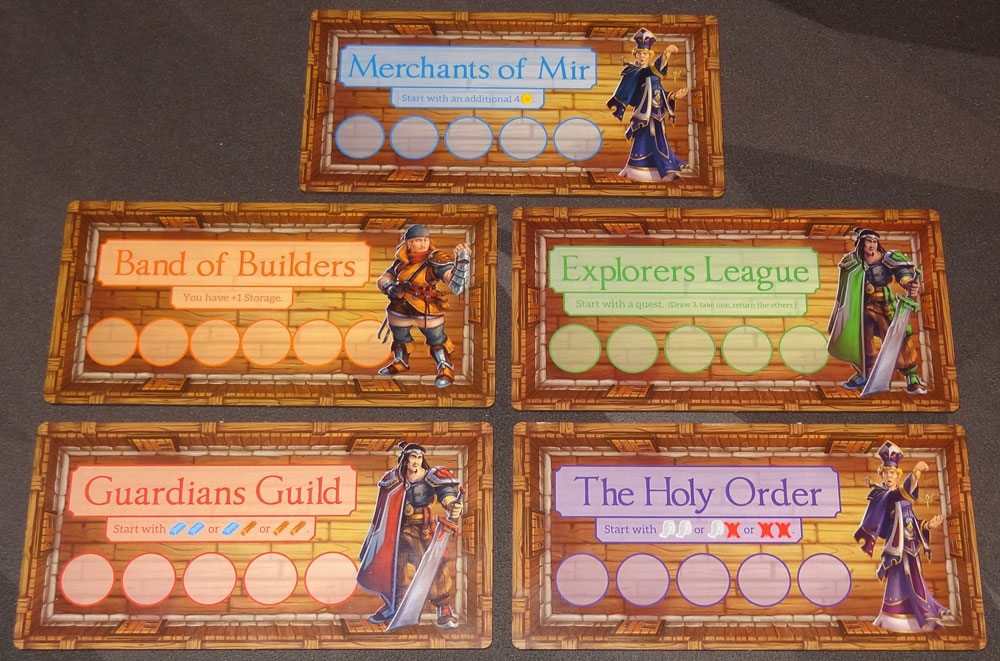
Each player takes a guild tile, the “sold” markers for their guild, and any start-of-game bonuses indicated on their guild tiles. In addition, players will start with some money (based on number of players), with the first player having the least money.
On each turn, you get to take a single action: Gather, Craft, or Upgrade.
Gather: Take three of the same type of resource, or two different resources. You may not take Gems or Magic unless you have built the Gem Workshop or Magic Arcaneum, respectively. If you go above your storage limit, you must immediately discard back to the supply.
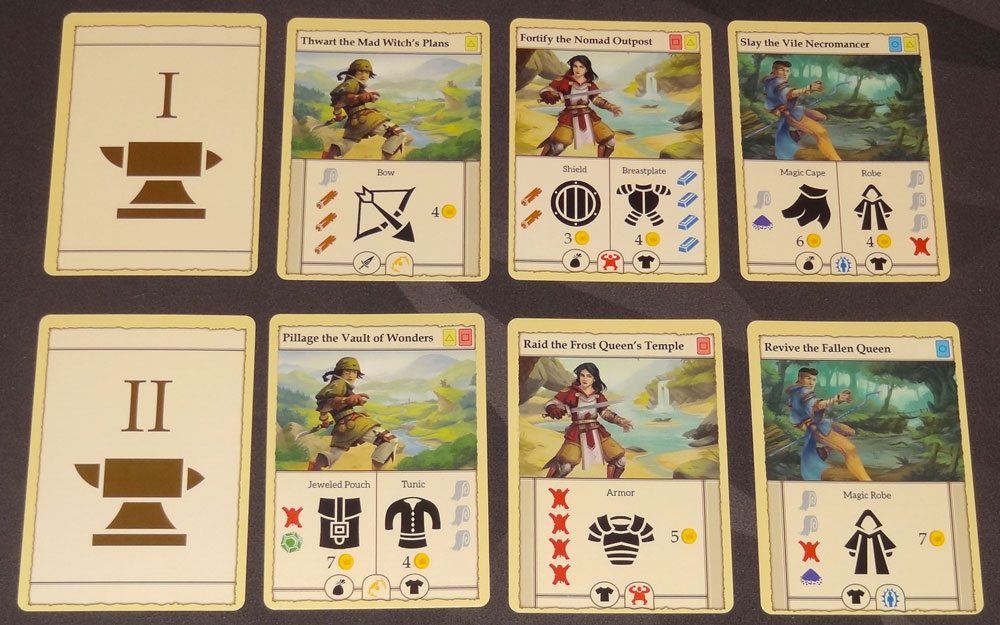
Craft: Spend the resources required to craft one or both items required for one of the face-up quest cards, and then take the gold amount shown for the item. If all of the items required have now been crafted, the quest is completed. Otherwise (if you crafted the first of two items needed), mark the item you crafted with a “sold” marker.
When a quest is completed, the players who crafted the items will get treasure cards, as indicated on the quest card. If you completed all of the items, you get all of the treasure cards. If you created the first item in a two-item quest, you choose one of the two rewards first, and the other player gets the other reward. “Sold” tokens are returned to their owners. Finally, the person who crafted the first item for a quest receives the quest card itself. Draw a new quest card to fill the space.
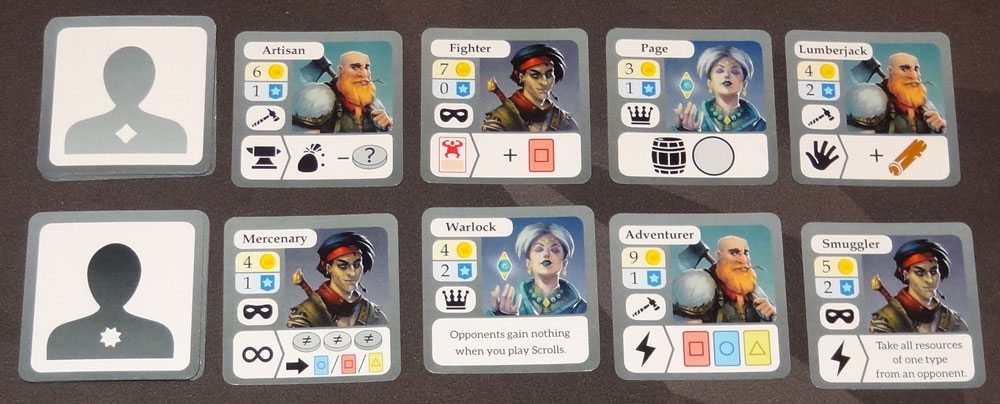
Upgrade: Purchase one room and/or hire one worker. You may only purchase a room you don’t have already, and you may purchase any of the available rooms: common rooms, halls, and chambers. To hire a worker, pay its hire cost, and then place the worker in front of you. In addition, add 1 coin to each worker to the right of the one you hired, which discounts its price. If a worker is reduced to 0 cost, remove it from the game. Then slide all the workers to the right to fill up the spaces, and draw new workers until the row is full.

Those are the basic actions. You may also play or sell as many treasure cards from your hand as you wish. Most treasure cards are worth 2 coins each if you sell them. There are also some cards like scrolls and potions that have effects when played, and cards that are worth points at the end of the game. You have a hand limit of 7 cards—if you have more than that at the end of your turn, you must play or sell cards until you have 7 or fewer.
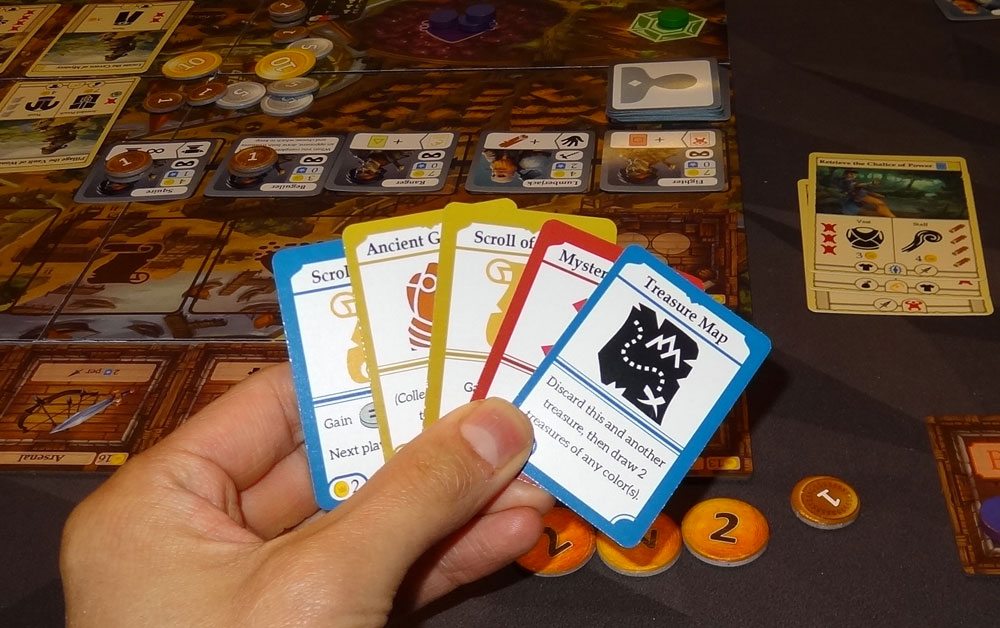
When the king’s herald is drawn, everyone bids an amount of money simultaneously—whoever bids highest pays the money to the supply and takes the card, which is worth 4 points. Everyone else keeps their money. In case of a tie, the card is discarded.
The end of the game is triggered when the king card is drawn: each player gets one more turn, and then the game ends.
For the last turn, there’s one other action you may choose: Offering to the King. Place one of your “sold” markers on the King card. You will then get 1 point for every 4 coins and 1 point for every 2 resources at the end of the game. You may not take this action if you have no “sold” tokens available.

At the end of the game, you score points as follows:
- 2 points per relic card, plus 5 points if you have the most relics (or are tied for most)
- 1/5/10/15/20/25 points for sets of 1/2/3/4/5/6 different artifacts
- 1 point for each completed quest card
- Point values for workers
- Point values for rooms
- 4 points for the king’s herald, and points for money and resources if you made an offering to the King
The player with the most points wins, with ties going to the player with the most money.

The Verdict
I first saw a prototype of Guild Masters at the Mirror Box Games booth at Gen Con this year, and designer Matthew Austin gave me a quick overview of the game flow. It’s actually quite straightforward to play, and once you’ve gotten everything sorted and set up, it’s easy to dive into the gameplay. The fact that you can only do one action per turn—gather, craft, or upgrade—means that turns will go fairly quickly, particularly in the first half of the game, when you don’t have a lot of bonuses in play yet. However, as you acquire workers and powerful treasure cards, you may be able to do more during your turn by playing a scroll to get more money before you upgrade, or hiring a worker that gives you an immediate effect.
The gathering and crafting portion reminds me a little bit of Splendor: you just take whatever resources you want, but you get more if you take the same type, and you can only keep a limited number of them unless you upgrade your storage with a warehouse or certain workers. Get the right set of resources, and you can craft an item to earn income. So there’s some set collection going on in terms of what resources you want to collect—and since the resources themselves are fairly limited, you have to plan ahead. There are also various workers that can give bonuses for these phases, like allowing you to get extra resources whenever you gather, or giving you discounts when crafting certain items.

Set collection comes up in scoring, too: since you can only have seven treasure cards in your hand, you’ll have to make some tough decisions about which ones to keep. Relics are only 2 points apiece, but a bonus 5 points if you have the most. Artifacts can be worth a lot of money, but you’ll have to dig around to find different ones. Scrolls can be worth 4 points apiece, but only if you spend money on the Library—and then you’ll be stuck deciding (as I did in one game) when to use a scroll for its ability, because every scroll you use is 4 points you’ve just discarded.
I like the different types of treasures, too. All of the decks have scrolls and potions (of different types), and each one has two of the six artifact types. Only the blue deck has cards that give you building resources when played. Only the red deck has relics. Only the yellow deck has coin purses, which give you money immediately. Knowing what’s in each deck and what type of treasure you’re looking for can also drive which items you want to craft.
And then there’s more set collection in the type of quests you complete, but only if you have the right chambers built. The mix of chambers will be different each game, and that can drive a bit of the strategy. There are some that give you points for having rooms or workers or money, but most of them pertain to the quests themselves. Each quest has a hero type—warrior, mage, or rogue—and each item you craft also has a type—weapon, armor, or accessory. When you complete quests, you not only get treasure cards, but also these quest cards; the number of chambers available may drive your decision on which quests to complete—but at the same time, the chambers are priced high enough that you may not be able to build one until much later in the game. That makes for some interesting tension, because if you spend a turn (and money) buying a room, other players may be completing the quests you need to score for that room.
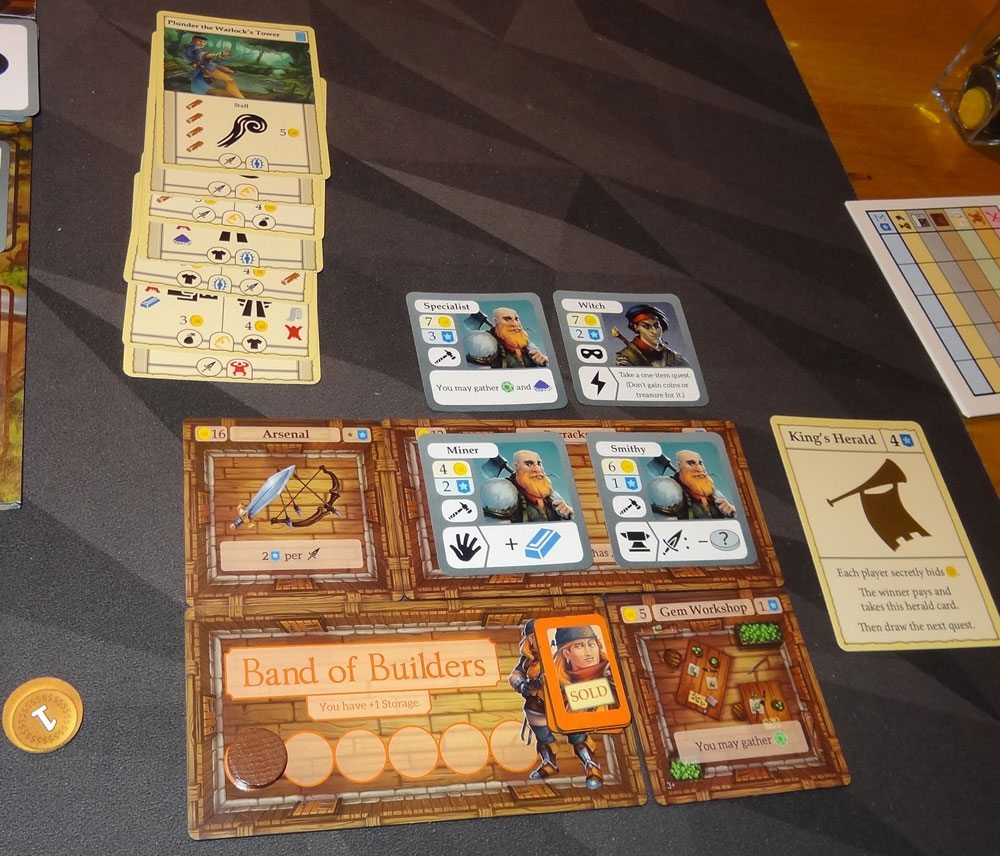
It can also be tricky deciding which items to craft, particularly when there are partially completed quests. Do you finish off the quest that another player started? They’ll get first pick of treasure and the quest card itself if you help them. On the other hand, if you don’t help and they craft it themselves, they’ll get all of the treasure. And, hey, maybe you just need some cash right away.
I like the fact that the gameplay is easy to learn, but that there are a lot of different strategies you can take while playing, and that there are a lot of interesting, meaningful decisions you must make with your one action per turn. I found myself really enjoying the theme of Guild Masters, too: it was fun to think about outfitting heroes for their quest and being a regular person in a fantasy world instead of one of its heroes.
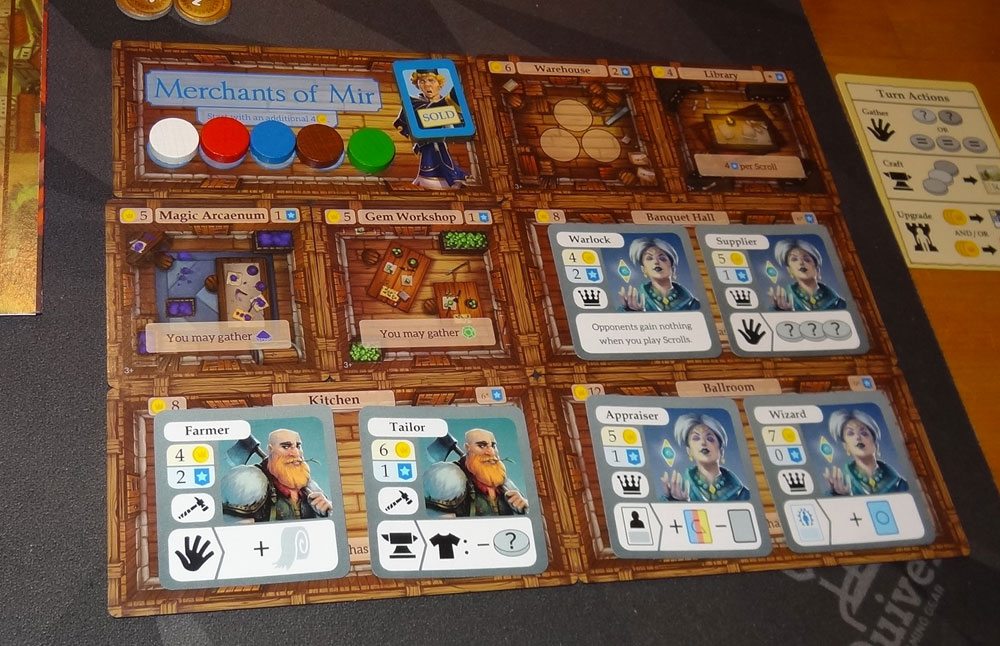
So far I’ve only been able to play 3-player games so I haven’t experienced the 4- or 5-player game, but it does seem like it would scale fairly well, though with a little more downtime between your turns. Still, it’s a game in which you’re always watching what other people are doing because it will have an impact on your own decisions, and that keeps the game moving so you don’t lose interest.
Overall, I think Guild Masters is a pretty fun game that’s fairly easy to learn yet still has room for challenging choices. If you like the idea of managing resources and building up a guildhall (while heroes go off on their quests), it’s definitely worth trying. For more information, or to make a pledge, visit the Guild Masters Kickstarter page.


